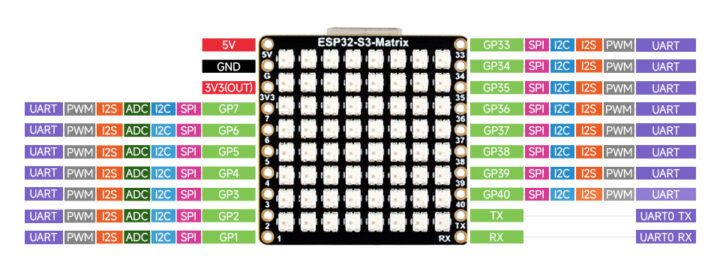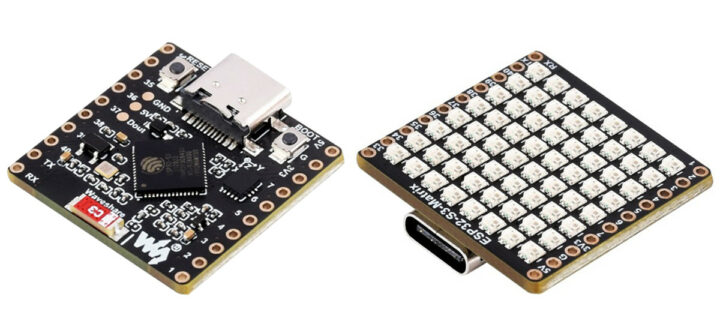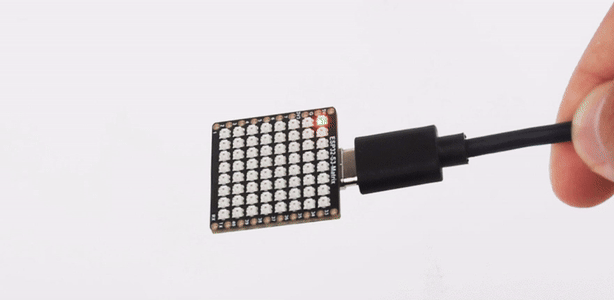The Waveshare ESP32-S3-Matrix is a microcontroller development board designed for AIoT applications, featuring a larger 8×8 RGB LED matrix (64 LEDs) compared to the 5×5 RGB LED matrix (25 LEDs) on the ESP32-C3/ESP32 based “C3FH4 RGB” / “PICO D4 RGB” board. In addition to that the Waveshare board features two 10-headers for GPIOs, UART, and power signals, along with an integrated QMI8658C attitude sensor (9-axis IMU sensor), making it ideal for robotics and motion control projects.
Recently we have seen Waveshare introduce affordable products that are perfect for embedded development like the $15 1.69-inch IPS touch LCD module, the $6.99 ESP32-C6-Pico Board, the $4.99 ESP32-S3-Tiny board and much more feel free to check those out if you are interested in those.
Waveshare ESP32-S3-Matrix dev board specifications:
- MCU – Espressif Systems ESP32-S3FH4R2
- CPU – Dual-core Tensilica LX7 @ up to 240 MHz with vector instructions for AI acceleration
- Memory – 512KB RAM, 2MB PSRAM
- Storage – 4MB QSPI flash
- Connectivity – 2.4 GHz WiFi 4 and Bluetooth 5.0 LE with support for long-range, up to 2Mbps data rate, mesh network
- LED Matrix – 8 x 8 Addressable RGB LEDs
- Sensor – QMI8658C 6D MEMS IMU with 9-axis sensor (3-axis accelerometer, 3-axis gyroscope, 3-axis magnetometer)
- Connectivity and Interfaces
- Up to 15x multi-function GPIO pins via 2x 10-pin headers with 2.54mm pitch
- Peripheral interfaces include SPI, I2C, UART, ADC, PWM
- Antenna – 3D PCB Antenna
- Power Management – ME6217C33M5G low dropout LDO capable of delivering 800mA (Max)
- Additional Features
- Additional onboard Dout pin (for connecting External LEDs)
- RESET button, and BOOT button
- Dimensions – 25 x 25 mm

Like other waveshare boards, the company provides a detailed specification diagram, making it easy to identify every major component of the board. This diagram also works as a troubleshooting guide, as you can now quickly pinpoint any faulty components using the diagram as a reference.
The company also provides a pinout diagram making it easy for you to get started with the board or add other peripherals to the board.
Regarding software support, the board can be programmed with ESP-IDF, Arduino IDE, and MicroPython, which are available from their respective websites. Additional documentation, such as the pinout diagram, installation guide, live example images, and links for all the resources can be found on their wiki page.
You can purchase the Waveshare ESP32-S3-Matrix board on Amazon for $15.99 (including shipping) and on Aliexpress for $10.26 plus shipping. Alternatively, it can also be directly bought from the Waveshare store with a price tag of $8.99 (not including shipping).
Debashis Das is a technical content writer and embedded engineer with over five years of experience in the industry. With expertise in Embedded C, PCB Design, and SEO optimization, he effectively blends difficult technical topics with clear communication
Support CNX Software! Donate via cryptocurrencies, become a Patron on Patreon, or purchase goods on Amazon or Aliexpress. We also use affiliate links in articles to earn commissions if you make a purchase after clicking on those links.







These are NeoPixel RGB LEDs, so expect 64 x 3 x 20 mA + 240 mA with full white color and Wi-Fi on, that is 500 mA, the maximum the USB 2.0 can deliver with negotiation, quite a lot of power
Since when is USB 2.0 limited to 500mA? Did I miss something or why does my phone with micro USB charges with 2A?
And well, to call 2.5W a lot of power is also quite funny…
in spec it is 2.5W so 5V*0.5A. With usb 3.0 the specs were raised to 1.5A, however with negotiation. Which is not implemented here.
Nor does this board support negotiation over PD.
OFC it will work if you use a dumb power supply with enough current.
Do you maybe confuse minimum with maximum?
Why does my phone (usb2, micro USB) charge with 5V@1.8A on my old laptops USB2 port?
I should note that isn’t in spec. Whether a device allows more current is up to the device, but it isn’t something that can be relied upon.
Those smaller “Neopixels” are 3~5mA per channel.
I believe they are sk6812-ec20 LEDs
I count fifteen GPIO… What am I missing?
>
Connectivity and Interfaces
Up to 15x multi-function GPIO pins via 2x 10-pin headers with 2.54mm pitch
We initially wrote 20 GPIO pins, but updated that yesterday, and I forgot to mention it here.
Amazon shows out of stock indefinitely
Mine shows 20 pieces in stock with the shipping address set to the White House.
This is probably the special white house contingent.